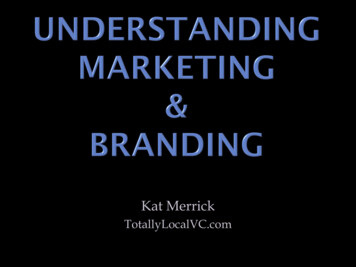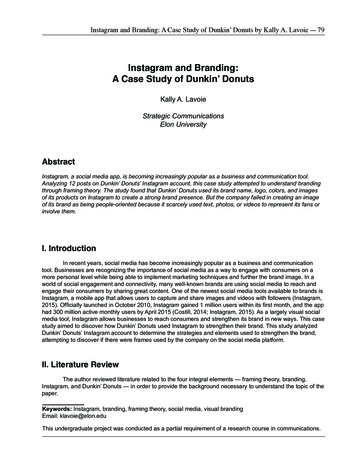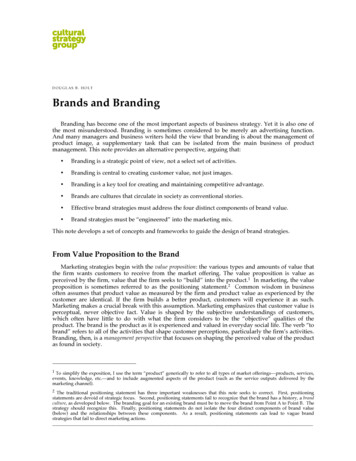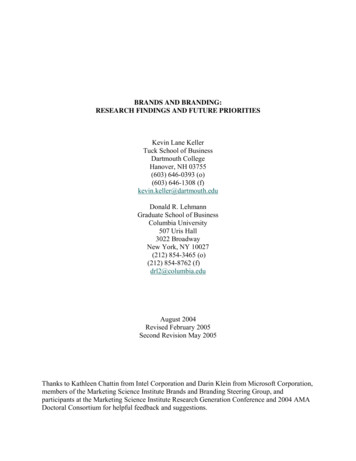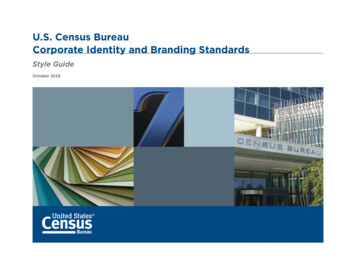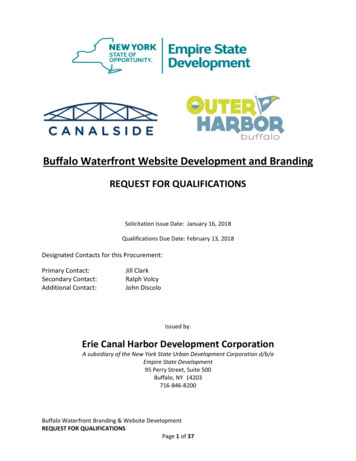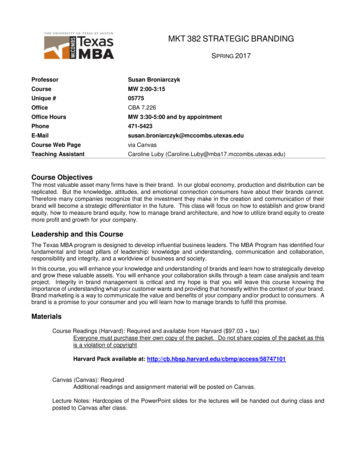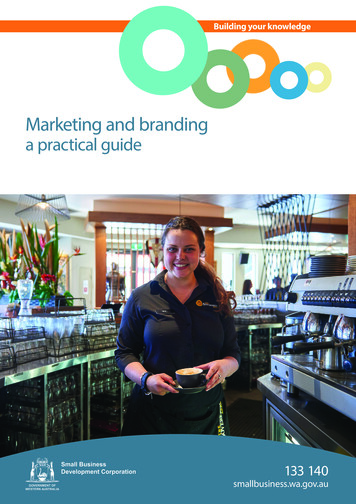
Transcription
Building your knowledgeMarketing and brandinga practical guide133 140smallbusiness.wa.gov.au
A practical guide toMarketing and brandingMaintaining and developing a successful, sustainable business depends on yourcustomers’ perception and experience of your product or service. Marketing is the processof getting your business noticed by the people who need or want what you have to offer.Branding is differentiating yourself from your competitors by creating a unique impressionof your product or service in the mind of customers.People often use the terms ‘marketing’ and ‘branding’ interchangeably. The key differenceis that marketing is what you do while branding is what you are.Having a clear and comprehensive marketing and branding strategy will ensure yourbusiness is sustainable and assist in differentiating you from your competitors.Steps to marketing your business1. Conduct market research2. Profile your target markets3. Identify your unique selling proposition4. Develop your business brand5. Develop your marketing plan6. Action your marketing plan7. Monitor and manage your marketing1. Conduct market researchMarket research is a key part of developing your marketing strategy. It’s about collectinginformation that provides an insight into your customers’ minds so you understand what theywant, how they gather information and where they are located. It’s also important to researchmarket trends and what’s happening in your industry.Before you begin researching your market it’s important to be clear about how your product orservice will benefit potential customers. This will help you focus on gathering relevant informationto develop a robust marketing plan.
Market research in three easy steps1. Define the information you needReasons to conductmarket researchThe type of information you need to knowIdentify potential customers Understand existing customers What do they value? Is it the level of service, product quality orWho is likely to use your product or service?How old are they? Are they male/female, married/single?Do they have children?Where do they live?What is their level of education?prestige associated with using your product or service? Who influences their buying decisions? Which websites do they visit?Understand your competitors Develop strategies Understand the environment associated with pricing, products,Who are your direct/indirect competitors?Who is targeting the same market as you?What types of marketing campaign are they undertaking?Are they successful in their approach? If so, what’s working?Why is your product or service preferred over the competition?distribution and promotional channels. Use your research findings to make informed marketing decisionsabout how to price and distribute your products or services.Prepare for business expansion Research will help you identify areas for expansion and test themarket’s readiness for a new product or service (eg. decidingwhether to open a second retail store and choosing the rightlocation).Identify new opportunities Your research could identify new business opportunities,under-serviced markets, changing industry trends, populationshifts, increasing levels of education or changes in leisure activities.2. Gather information from a varietyof sourcesIt’s important to use a range of resourcesso you can cross-reference information andbuild a detailed picture of your chosen targetmarkets. Depending on your industry, a greatdeal of information may already be availablein published reports or studies. This is knownas secondary data. However, to gain a betterunderstanding of your target markets it’s agood idea to conduct your own research –this information is called primary data.Primary data includes: customer surveys focus group discussions feedback from customers (potential orexisting) monitoring social media and website pages Google Ads, Google Keyword Planner,Facebook advertising, and FacebookInsightsSecondary data includes: Australian Bureau of Statistics (ABS) industry associations data providers (eg. IBISWorld) local councils
1. Conduct market research (continued)3. Analyse the resultsWhen analysing the results it’s essential toremain objective. As you review the resultskeep the following in mind: flawed survey questions produceflawed resultsbe aware of your own biasestrends may be hard to spot, so instead lookfor similaritiesbe honest with yourself - don’t ignoreresults that are different from those youexpectedUse the findings from your analysis todetermine the best way to raise awareness ofyour products or services to the right people.If research shows your proposed business isunlikely to be successful, it may be time torethink your concept or strategy.Access free IBISWorld reports coveringmore than 500 Australian industries atour office.Visit smallbusiness.wa.gov.au to findout more.2. Profile your target marketsLearning about your customers and offering products or services that meet their needs is anessential aspect of marketing. Trying to promote your product or service to everyone is costly andineffectual, so market segmentation is essential. By splitting your potential customers into clearsegments, you can tailor your message to suit them and gain greater value from your marketingbudget.Market segmentation involves dividing your broad target market into subsets of consumers withcommon needs. There are a number of ways to segment a market.Type of segmentationVariablesGeographic Where do they live?Where do they work? What is their family situation?What do they value in their lives?What are their hobbies and interests?Do they have children?Do they have pets?DemographicLifestyle and valuesBehaviouralAre they male or female?How old are they?How educated are they?What are their most common job types?What is their average income?What is the primary reason they would use your product or service?What appeals to them about your particular brand?What are their usage rates of your product or service?Where do they typically source information about your type of productor service?
3. Identify your unique selling propositionYour unique selling proposition (USP) is thereason your customers buy from you andnot from your competitors – it’s what makesyour business stand out from the crowd. It’simportant to define what you do differentlyand be able to convey that to potentialcustomers.You should be able to state your USP in a shortsentence. For example, Kmart has capitalisedon the phrase ‘irresistibly low prices’; thisappeals to their market and sets them apartfrom other low-cost clothing retailers.Start developing your USP by answering thefollowing questions: What do customers love most about yourproducts or services?What makes customers come to you insteadof your competitors?How do customers benefit by purchasingyour products or services?Which aspects do you generally highlightwhen describing your business to strangers?4. Develop your business brandEvery business, regardless of size, needs abrand. A brand is more than a logo, tagline orcolour. A well-articulated brand emotionallyconnects with your target customers andconveys who you are, what you stand for andwhat you can deliver.The branding processCreating a new brand or revamping an existingone (if you’ve purchased an establishedbusiness) essentially follows a three-stageprocess.1. Define your brandYou can define your brand by creating asimple list or, in larger businesses undertakinga workshop, with key employees. Address thefollowing: In one sentence, what does your businessstand for?How will this be shown through youractions?How will customers experience this whenusing your product or service?What will be your customers’ experiencewhen using your product or service?When defining your brand: identify your core valuespromote a consistent, simple messageask staff ask for their inputavoid exaggerated claimseverything you do should reflectyour brand2. Develop your brand’s visual identityA logo on its own has no meaning. However,over time a brand’s visual identity will take onattributes resulting from people’s experiencesof the product or service. This is why it’simportant to initially define your brand.
4. Develop your business brand (continued)What your business stands for will determinethe following five elements that make up itsvisual brand. Business name: Whether you choose a quirkyor functional business name, make sureit’s easy to pronounce and spell. Try to usekeywords (eg. plumbing) in your businessname, this will help with website searchengine optimisation (SEO). Logo: Keep it simple and easy to read, itmust also be scalable and still be effectivein black and white. Be original and creativewhen designing your logo. Colours: Choose colours that reflect yourbusiness and create the desired emotionalresponse from your target audience. Tagline: Use around three to seven words.It should sum up your brand’s position andstick in the minds of your target market.Great examples include Nike’s ‘Just do it’and L’Oréal’s ‘Because you’re worth it’. Fonts: It’s a good idea to use commonfonts, for example Arial or Verdana, as theyare easy to read and are standard on mostcomputers and mobile devices. The samefont should be used consistently across allyour marketing materials.It’s a good idea to employ a professionalgraphic designer to develop your logo andselect your fonts and brand colours. They’llunderstand what works best across a rangeof online and print materials.3. Manage your brandDeliver a consistent brand experience,understand your brand’s value and seekopportunities to build your brand’s reputation.Look at ways to be proactive in your industryand to give back by sharing knowledge orexperiences.Protecting your brand through trademarkingmay be beneficial for your business. Visitipaustralia.gov.au to find out more.You should be able summarise in60 seconds what your business is about,why customers need your product orservice, and how you satisfy that need.This is called an ‘elevator pitch’; astatement that can be delivered in lessthan a minute (ie. the time it takes totravel between floors in a lift).Often that’s all the time you have tointroduce yourself and capturesomeone’s interest.Reviewing an established brandIf you have purchased, or are consideringpurchasing, an established business youshould review the strength and relevance oftheir existing brand. This should be includedin your financial evaluation of the business’sviability.Purchasing an established business doesn’tmean having to change its branding; in somecases this can be detrimental, especially if theprevious owners had built a strong, positivereputation.If you suddenly change the brand, customersmay not know who you are and work will beneeded to regain a name in the market.
5. Develop your marketing planWhen writing a marketing plan, be clearabout your objectives and how you’re goingto achieve them. A good marketing plan setsrealistic and measurable objectives, allocatesresponsibilities, and includes budgets andaction plans. Update it regularly to reflect thecurrent position of your business.A marketing plan should include the followingkey elements:1. Business analysisThis is a snapshot of your current position,where you have been and where you want togo. Include these details: mission statement (What is the fundamentalpurpose of your business? From acustomer’s point of view, why do you exist?)vision statement (What do you see for yourcompany in ther future?)objectivesproduct or servicesfinancial analysisSWOT analysis (a review of the strengths,weaknesses, opportunities and threatsrelating to the business)2. Market overviewPart of determining how you differ fromcompetitors and where your product orservice will fit into the existing market isanalysing your: marketcustomers/clientscompetitors’ offeringsexternal factorsThis should be revisited regularly to ensureyour strategy remains relevant and targeted.Your objectives should be ‘SMART’ (specific,measurable, attainable, relevant and timebased). For example: To gain 15% of the market for campingstoves by December 2020 (a market shareobjective). To make your orange juice the preferredbrand for 21-29 year old females in Australiaby August 2021 (a branding objective).4. Marketing strategyIt’s important to be able to promote yourproducts or services effectively. Providinggood customer service and having amarketing strategy in place will help yougenerate sales. In marketing there are ‘six Ps’ –the six key aspects that you need to focus onwhen marketing your products or services.ProductWhat are your core productsor services?PriceHow will you price your productsor services to cover all costs, makea profit and stay competitive?PromotionWhat are the best ways topromote your products orservices to your target markets(eg. website, social media,brochures and flyers, blogging,mail-outs, letter drops, word ofmouth, networking, radio or printadvertising)?PlaceHow will your customers beable to purchase what you areoffering? Will it be online, in-storeor through other distributionchannels?PeopleHow many staff will you needto operate your business? Whatskills do they need? How will youtrain your staff to deliver the bestservice possible?ProcessWhich customer serviceprocedures and businessprocesses do you need toestablish to ensure that your salesprocess is smooth?3. Market objectivesObjectives may be financial (aiming to increasesales) or marketing focused (aiming to buildawareness of your product or service).
5. Develop your marketing plan (continued)5. Specific activitiesPlan the specific activities you will undertaketo achieve your marketing objectives.The activities must align with your marketingstrategy.6. FinancesA rule of thumb is to spend between three andfive per cent of your actual or expected annualturnover on marketing. If your business is newyou may need to allocate more funds to buildyour business profile. Use financial statementsand proje
Branding is differentiating yourself from your competitors by creating a unique impression of your product or service in the mind of customers. People often use the terms ‘marketing’ and ‘branding’ interchangeably. The key difference is that marketing is what you do while branding is what you are. Having a clear and comprehensive marketing and branding strategy will ensure your .
